- Ranga means stage and the Lord. Know about
performances devoted to the Lord in Bengaluru and their deeper meaning in Natya.
आङ्गिकं
भुवनं यस्य वाचिकं सर्ववाङ्मयम्
आहार्यं
चन्द्रतारादि तं नुमः सात्विकं शिवम् ।।
āṅgikaṁ bhuvanaṁ yasya vācikaṁ sarvavāṅmayam |
āhāryaṁ candratārādi taṁ numaḥ sātvikaṁ śivam || 1 ||
‘Nandikeśvara’s Abhinayadarpanam in its first verse, says - I bow down to Lord Śiva, who is the personification of the sentient being (sāttvika), whose movement of the body/comprising of limbs (āngika) denotes the universe (of space, time, matter and energy) and happenings in the universe, words emanated from whom (vācika) is the source of all sounds (spoken - heard and unheard) and who is adorned by moon and stars (āhārya) - the celestial objects.
The undifferentiated sound becomes differentiated through
the vibration of Damaru. Damaru stands for Sound, the essence of space of
which Natarāja is the Lord and as the subtlest of all elements, signifies
creation.
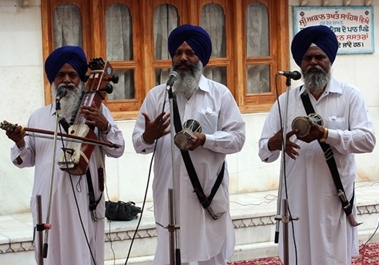 Damaru in hands of those on right of pic, at Hari Mandir Amritsar. 2014
Damaru in hands of those on right of pic, at Hari Mandir Amritsar. 2014The Ātman or Self being the real teacher of the human
mind, Natarāja is meant to represent the
Teacher or Guru. There are two kinds of Gurus- the apparent and the real, the seen and the unseen. The former is the teacher who
instructs the disciple and takes him along the path- this is
what we usually mean by the word Guru; but all
teaching really comes from inside, not merely in the sense that the
outward apparent teacher is but the instrument employed by Ātman or God,
but also in the sense that all growth is from within. The plant, for
example, grows from within; the manure, water, etc., are simply
aids to its growth. In the same way, the mind grows only from within,
assimilating of course the teachings from outside.
Natarāja then, is the real Guru, concretely represented. One
of the functions of the Guru, perhaps the most important, is
to be what he teaches, by example.
The Paramapara of Guru and Sishya is unique and is a testimony to our
artistic heritage. The traditions are passed orally and hence they last for
ages- Sanātana. Nātya is one such indelible treasure.
The music, dance and drama are to be performed, basically as propounded by Bharatmuni’s Nātya. Various aspects flow like rivers, each entity arising and descending as parts of the whole, like an Alāta Cakra- a spinning wheel of fire. A dancer enters the stage, always invoking the grace of the deities. The sacred geometry, inherent in the dance consecrates the space on stage with the music ensemble.
The enactment of emotions representing the world drama connects the dancer to the spectators through the principle of Sahrudaya. Empathy ensues when the Rasika discovers these predominant moods as existing within. It is indeed to be emphasized that the common thread that connects all the beings in the ambit of the ‘Kśetra’ or stage, is the opportunity to attain the taste of self-realisation through aesthetic relish- Rasa.
Ranganātha and Natarāja mean the very same thing,
differently expressed.
Natarāja is the Lord of the stage, so also Ranganātha (Ranga
means stage). The stage is the stage of the world, of the cosmos, or better
still of the body and the senses. A theme centring around the Lord who
preserves, maintains, sustains and blesses one and all is a vital bulwark
against deterioration of the arts. There are many aspiring artists whom we meet
these days, who are trying to keep the stage presence by supporting one another
through their self- curated festivals of dance.
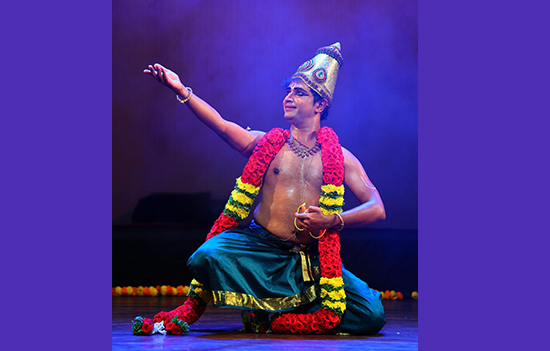 Darshan Shankar at a festival held in Bengaluru in March 2025
Darshan Shankar at a festival held in Bengaluru in March 2025
One such was held in March 2025, called ‘Kapardhini,’in Bengaluru. Darshan Shankar organised it as is his annual custom, with an intention of giving back with gratitude to the field; on a positive note. He himself presented ‘Pallāndu’ - the praise. 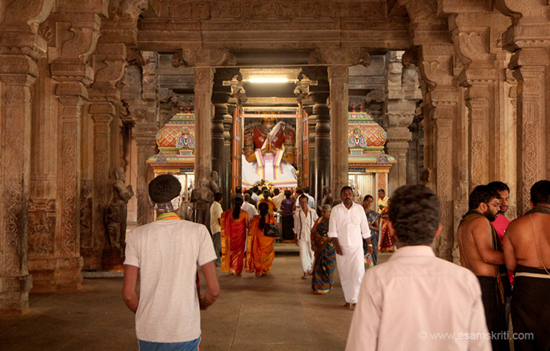 Garuda at Srirangam Temple Trichy. 2016
Garuda at Srirangam Temple Trichy. 2016
He was poised and serene in his embarking on a pilgrimage to
the revered Srirangam temple, on the banks of Kaveri river. The grandeur of the
Kśetra, with its intricate architecture and sacred rituals became projected
before our eyes, not to overlook the majestic Garudavāhana of Lord Mahāvishnu.
The Areiyar Sevai was woven with a
tribute to the legendary Vellai, who was a brave Devadāsi who had risked her
life to protect the Utsava Murty from the invading Mughal king Maliq Kafur. According
to local tradition she distracted the king and his army, and even paved way for
his death from the top of the Gopuram. This production was premiered in the
event. The entire music composition and dance was non-stop.
Instead, if it had been chiselled to three- four parts, the
impact could have been enhanced. Perhaps, the continuous reverb from the
instrumental section is to be monitored as well.
The Śāstra calls it Śṛingāra -Love; and is given the first place as the Rasa Rāja; in its portrayal is the inherent scope to touch upon many other Bhāva-s. Taking its three basic delineations as Vātsalya, Rati and Bhakti, it becomes delectable in every form. The arrows of Kāmadeva intensify the pangs of separation and love merges into Saranagati or total self- surrender.
‘Sharana’ (refuge) and ‘Agati’ (arrival) signifies liberation from ego; a sense of separateness from the Lord is dissolved. It cultivates a sense of unconditional love and devotion.
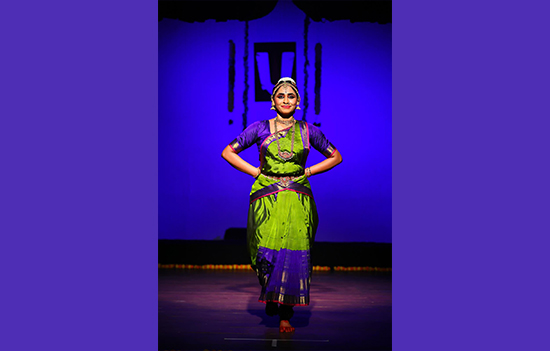 Smt Bhanu Priya Rakesh in Varnam
Smt Bhanu Priya Rakesh in VarnamSmt. Bhanu Priya Rakesh presented a Varnam. Immersed in her art, she gave a power-packed presentation. ‘Mohalaahiri Konden Samy’, a composition of Tanjavur Sivanandam in Raga Todi and Adi Talam, celebrates the courtesan who unabashedly and passionately expresses her deep anguish, laden with forlorn desire for Sri Rajagopala Swamy of Mannargudi. Choreographed by the dancer’s Guru, the Varnam took a slightly variant form while delineating the psychological states, when compared to older versions by the Tanjavur lineage which are often cut to a set standard. The balance in the music ensemble, specifically percussions and flute as opposed to vocals, could have been slightly better.
Kumari Harinie Jeevitha, who propels a ‘cheer’ with every move, especially amongst the young and chirpy spectators presented 'Varadarãjam Upasmahè', a thematic production based on the Brahmotsavam (the grand, ten-day annual temple festival) of Varadaraja Swamy of Kanchipuram.
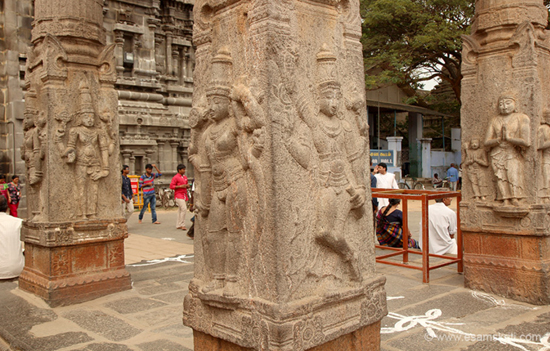 Pillars at Varadaraja Swamy Temple, Kanchipuram
Pillars at Varadaraja Swamy Temple, Kanchipuram Adhering closely to the conventional Margam format, it included the splendorous sight of 'Kulukkal' of the Utsava Moorthy. An invocation with Irandaam Kaappu depicted a devotee, suffused with love for Lord Varadaraja, witnessing the Lord mounting the Hamsa Vahana. The graceful and agile dancer’s Varnam had strung verses from Swami Desikan's 'Mei Viratha Maanmiyam', Bhoodathazhwar's Pasuram and Sri Doddacharya's 'Devaraja Panchakam'. Sthala Puranam and Garuda Sevai were portrayed in detail and iconography was the hallmark through this piece. The presentation concluded with a Tillana followed by a note of surrender to Lord Varadaraja, who grants infinite boons.
Total acceptance of the act by actor and spectator implies
dropping the ways of dialectical thinking. If we opt to choose, we are
fragmented by denying the other half, which is also the truth.
Bharatamuni keeps every Rasika on a high pedestal who is
endowed with the fruits of good Karma to be able to witness stage performances.
Assumed to be gifted with erudition, it is the Rasika who determines the
success.
In the texts, there are two types of efficacy that are given
for staging the arts- Mãnushi and Daiviki Siddhi.
One is of human kind and the other is divine; obviously higher an achievement.
While the former is marked by applause, sometimes bordering on an uproar, the
latter bears a classy, soft approval. These days, while performances do see a
mixed bag, it is often the former that is looked upon as a benchmark. In all,
the evening saw Prema and Bhakti Bhāva, shining forth. The omnipotent,
omnipresent and omniscient Maha Vishnu
appears as the lotus eyed divine
flute player among his various forms and captivates the hearts.
Kriṣna is the favourite of many saint poets, being the Lord
with whom every ordinary person can easily identify with. Every aspect of Kriṣna
and His deeds is replete with highest mystical symbolism, indicating the
highest Truth. The incarnation of Kriṣna represents the descent of the Infinite
Brahman to the material world. Although there is no mention of him in the Nātya
Śastrā, he is another charming dancer while he is involved in Rāsaleela and
becomes a forceful subjugator of Kāliya during the Kāliya Mardhanam. The
serpent is symbolic of senses and Kṛiṣna overpowers it.
The modern period in dance evolution, has seen a plethora of
classical dances moving from temples to the proscenium theatre. With the
plundering of temples, Nātya had gradually ceased to be an important feature of
temple worship. Dancers however, gathered lessons from the erstwhile temple
dancers and later on, brought in innovations to suit changing tastes. While one
understands that art continuously evolves, one cannot afford to forget its
origins.
The emotional state leading to aesthetic rapture are all
built upon the foundation of the divine and is a supreme Yoga. We learn from
the Loka Nātya that, what is - Is. It was, when we were not and it will be,
when we will.
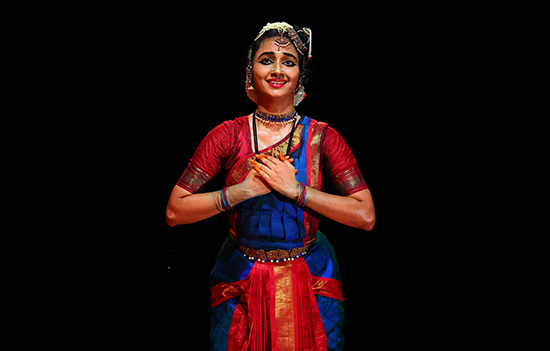 Harinie Jeevitha.
Harinie Jeevitha.
Three Dance pics by Universal Rasikas- Madhukar, Bengaluru.
References
1. Ghosh Manmohan, Nandikeshwara’s Abhinayadarpanam, Firma K.L.Mukhopahyaya, Calcutta, 1957
2. Kumar Pushpendra, Natyasastra of Bharatamuni - 3 Vols. ;
Text With Commentatry of Abhinavbharati and English Translation, New Bharatiya
Book Corporation , Chennai, 2006
3. Suresh Padmaja, The Dance of Tantra and a Satguru, Shubhi
Publications, Delhi, 2023
4. Krishna the perfect playactor by Suresh Padmaja
Author is an acclaimed dancer researcher and author, Dr.
Padmaja Venkatesh Suresh is well-known for her immaculate insight into esoteric
sciences, corelated with years of training and experience. Having toured
extensively with her lectures, workshops and thematic performances, she leads Aatmalaya
Academy,
Bengaluru that shares the cause of
Sanatana Dharma and Vedic values through the arts. A PhD in dance and
philosophy, she has several awards to her credit.
Read author’s first book Tantra
The Science and Natya The Art: The Two Faceted Reality
To
see albums
1. Srirangam Temple, Trichy
2. Varadaraja Swamy of Kanchipuram
3. Read Bharata’s Natya Shashtra
4. Creating Modern Dance Drama with Natya Shashtra